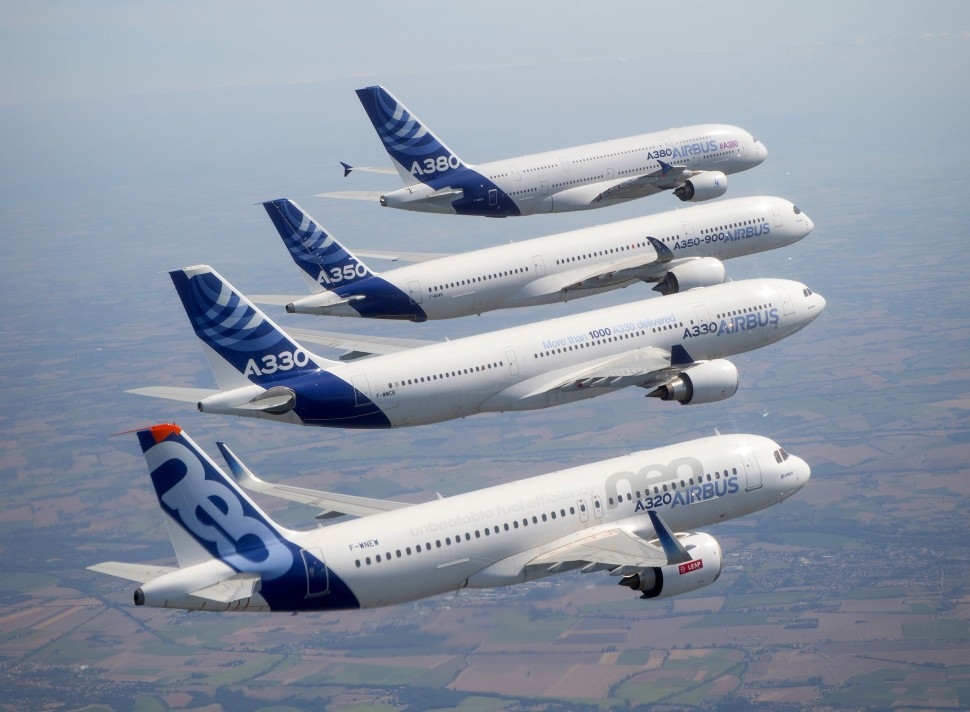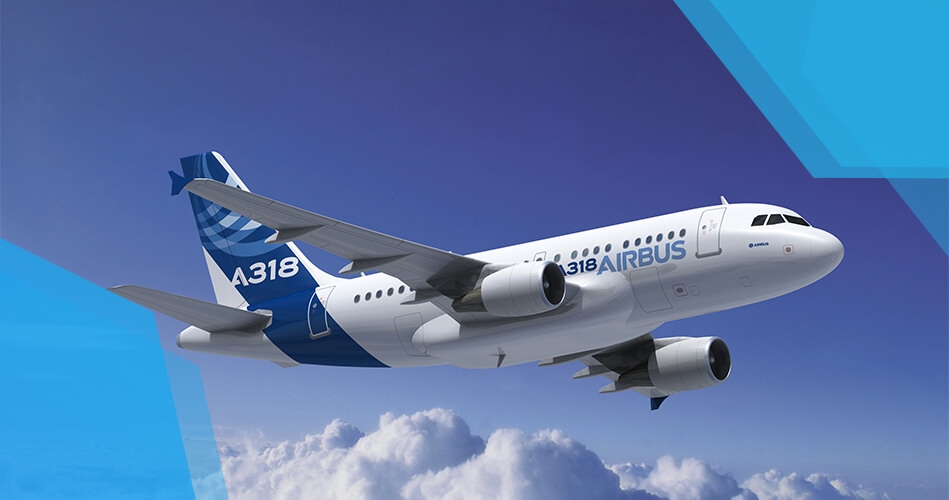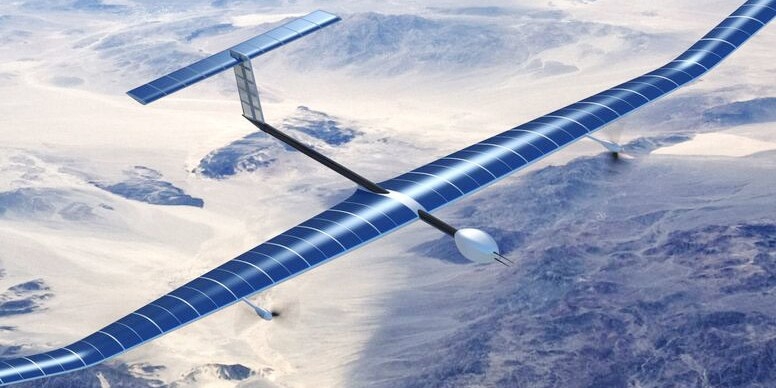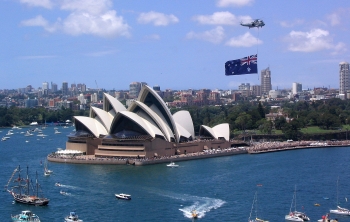17 Amazing Things About Airbus
 |
| Airbus family (Photo: Flightglobal) |
The Airbus is one of the most recognizable aircrafts that cross the skies globally and daily. There are many different airliners that fly the Airbus, and these are also some of the most reliable in the industry.
Here are 17 things you probably didn’t know about Airbus.
1. Rolls Royce engines
When you hear of Rolls Royce, you automatically think of luxury cars. However, Rolls Royce aircraft engines have been a thing since the early years of the 20th century. Rolls Royce aircraft piston engines were prevalent during the World Wars and the years in between. Many of these engines were used to power up a lot of fighter and bomber planes such as the Hawker Hurricane, the Supermarine Spitfire, and many others. The Airbus A380 contains four Rolls Royce engines that are the length of a Mercedes C-series sedan. Each of these engines are also four times as heavy. When in operation, these engines reach a temperature of 3100°F.
2. Takeoff weight
The A380 has two stories. It’s a huge aircraft. When it takes off, it has to take into account all that weight plus the effects of gravity. In fact, when it takes off, the Airbus A380 reaches a maximum takeoff weight of 575 tonnes. That’s about 1,267,658 lbs. If that’s still too difficult to imagine, that number is the rough equivalent of five blue whales taking to flight. It’s quite a feat of engineering to get something of that size off the ground and in the air.
3. The A320 is not just one aircraft.
The Airbus A320 is not just a one-size-fits-all aircraft. In fact, it is a family of aircrafts. The A320 is available in different sub-models with varying seating capacities. This jetliner family is considered one of the most versatile and successful in the world.
Airbus A320's original model was released in 1984. Over the years, different models were added to the family…in 1994, 1996 and 2003. Since 2003, the versions have been upgraded and modified multiple times, but no new versions of the aircraft have been added.
4. The Airbus A320 can land almost anywhere.
The Airbus A320 is a narrow body plane with two rows of seats and a single aisle. As a result of its smaller size design, it is highly versatile and can be used on almost any commercial route depending on the length of the journey.
The Airbus A320 flies throughout the world. This aircraft can land on the icy runways in Antarctica, runways in the desert and everything in between. This means that passengers can fly to almost any location on the Airbus A320. Depending on the specific model of Airbus A320 used, the aircraft can have a range of up to 4,000 nautical miles. By 2023, an Airbus A320 with a range of up to 4,700 nautical miles is expected to be available for commercial use.
5. Airport accomodations
When it was launched the Airbus A380 was the largest passenger airliner in the world. When it made its first flight, it was already 2005; you’d think that airports were already equipped to manage such large aircrafts. It turned out that the Airbus was too big for existing airports then. So airports had to fund upgrades in order to accommodate to the large Airbus. By 2007, the A380 was flying commercially through Singapore Airlines. Majority of larger airports are now equipped to receive and send off these Airbus aircrafts, but some mid-size to smaller airports are probably not even going to join in the game.
6. Fly-by-wire system
The Airbus A320 was the fastest-selling airliner in the world for many years when it was first released in 1984. It was popular for many reasons; but most of all, it became famous for its flight control system. The Airbus A320 was the first airliner to introduce the fly-by-wire flight control system. The aircraft always knows where it is at all times because the system is fully electronic and computer controlled. There’s no way that the plane or the pilot could exceed flight parameters because of this automation, as cites Moneyinc.
7. The first Airbus
The A300 was Airbus’ first aircraft in its product line. It was also the world’s first twin-aisle, twin-engine widebody airliner. It was first announced in 1969 and it took its first flight in October of 1972. Its first commercial flight was on May 23, 1974 for Air France, and the aircraft traveled from Paris to London. That commercial flight launched a huge sales drive for the company for many years. It became the favorite of many airlines including Air France, Lufthansa, Indian Airlines, and Korean Air among many others. The A300 has had several variants since its creation, and it continues to fly today in many markets.
8. Passenger seating
The Airbus A380 can accommodate for a large number of passengers. That’s a given considering that its one of the largest aircrafts in the world. In fact, the A380 can seat anywhere from 538 to 868 passengers. The discrepancy in the capacity is in the levels. The main deck holds 538 passengers while the upper deck can seat up to 330 passengers. Airliners can customize the configuration of their ordered aircrafts. For comfort, Airbus claims that 544 is the optimal seating number. Apart from Emirates’ 615 seats, the only airliner that came close to 544 is Air France’s 538-seater aircraft.
9. Airbus A318
 |
| Airbus 380 (Photo: Oxfordsaudia) |
The A318 is the smallest member of the Airbus A320 family in terms of size and passenger capacity, it can carry up to 132 passengers.
The aircraft may be smaller than other family members, however, it is the largest commercial airplane certified by the European Aviation Safety Agency (EASA) for steep approach operations, which allows the plane to take and land at airports such as London City.
Airbus A318 shares a common type rating with all other A320 family members, which allows A320 certified pilots to fly the aircraft without the need for further training or other certificates, according to Oxfordsaudia.
10. Corporate jets
Apart from jumbo commercial aircrafts, Airbus also has a collection of corporate jets. Their jets offer some of the latest advances in aerospace technology. These jets feature reliable Pratt and Whitney engines. Airbus corporate jets also feature advanced specifications that are beneficial to pilots such as extra navigational aids, weight-saving carbon brakes, and a few other features. With a corporate jet, you also become part of a global network of corporate fliers that can offer technical advice when you need it, flight training, and even spare parts.
11. The Airbus wingp
The largest Airbus, the A380, boasts a wingp that is just simply incredible. The wingp of an A380 measures 79.75 meters. That’s the equivalent of nine London double deckers standing side to side. This is necessary to lift all the massive weight of the aircraft. There are rumors that Airbus might be trying to expand its wingp further, which might mean that Airbus might be looking to expand its aircrafts even further. A larger aircraft would be another groundbreaking feat for Airbus and the airline industry altogether.
12. Made in Europe
Airbus is a pan-European product. Its many parts are made in different areas of the continent. Most of the major structural sections of their aircrafts are made in various countries such as the UK, Spain, Germany, and France. England makes the engines and some fuselage parts; Germany and Spain collaborates on the tails. The wings are made in North Wales. Fernando Alonso, Airbus’ test engineer, says that the Airbus A380 alone is a symbol of Europe and all its engineering ingenuity. These parts are shipped from all these countries by land, air, or sea to be assembled and finished in France.
13. The Lufthansa A380
By now, we get the picture that the Airbus A380 is absolutely massive. With the possibility of 500 to 600 people on board, you can imagine that the typical 15-person crew of a Boeing 747 will just not suffice. In fact, the Lufthansa A380 has to have at least 21 flight attendants at all times. These flight attendants work a total of 5 galleys. They all have rest compartment areas located at the rear of the aircraft. Part of flying an Airbus A380 is the feeling of luxury in flight. The only way to get that is if there’s enough staff to man the cabin appropriately.
14. Airbus helicopters
Many people might not know this but Airbus actually has a comprehensive line of helicopters. These helicopters are available for private use, corporate use, or even military use. Many police and military groups utilize Airbus’ helicopters as part of their arsenal. All their helicopters are built for performance and boasts excellent visibility and low vibration levels. Some of their helicopters are design13. ed specifically for various service-related work such as firefighting, law enforcement, search and rescue, and others. These helicopters feature a flat floor that’s easy to reconfigure depending on necessity.
15. Airbus and the military
The aircraft manufacturer has always been the go-to manufacturer for various armed forces groups throughout the world. Airbus has a collection of different kinds of aircrafts that serve different purposes when it comes to military use. They could be airlifters, tankers for refueling, Eurofighters, and a few others. These aircrafts use state of the art weapon systems using an integration of European and American weapons. Airbus’ military aircrafts are ready for combat or mission at any time. Some of Airbus’ customers include Austria, Kuwait, Qatar, the Sultanate of Oman, and the Kingdom of Saudi Arabia among others.
16. The Zephyr
 |
| Photo: Aeronautics |
Airbus is so ahead of the game that they even have a pseudo-satellite in their product line. The aircraft is called Zephyr, and it’s a High Altitude Pseudo-Satellite (HAPS). It’s the world’s first unmanned aircraft of its kind to fly the stratosphere of the planet, and it’s also the world’s leading solar electric and solar-powered satellite. It uses solar power exclusively, and it can go on flying for months at a time. The Zephyr is useful in both military and commercial platforms. Among its many capabilities, the Zephyr can perform voice and data communications, optical imagery, and real-time mapping.
17. Patents
| Airbus worldwide is all about innovation. The engineers at Airbus are nonstop in trying to improve their products or in trying to come up with new products altogether. The company is simply nonstop. This is the reason why the company currently has 37,000 patents worldwide. These patents help fuel the company’s products and visions. But while that may be the number, there are probably a few thousand more patents that are currently pending. There really is no stopping innovation and for Airbus, it’s something that happens daily. |
 | Top 12 Amazing Facts about Pepsi You May not Know PepsiCo is one of the biggest and wealthiest companies in the world, a multi-billion dollar brand that's pretty much taken over the globe. Follow us ... |
 | Top 17 interesting facts about Australia Top 17 interesting: Think you've heard a lot about Australia? There is something more about this interesting continent. Below are 17 little gems that might ... |
 | 17 interesting Facts About Russia That You Might Not Know 17 interesting Facts: Russia which is the largest country in the world is a transcontinental country located in Eastern Europe and Northern Asia. Factretriever states ... |


























